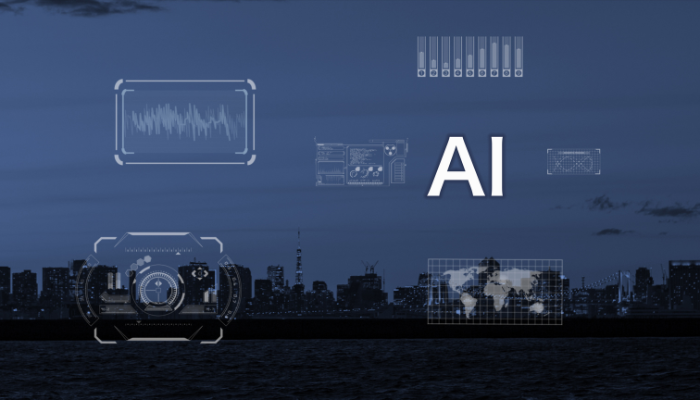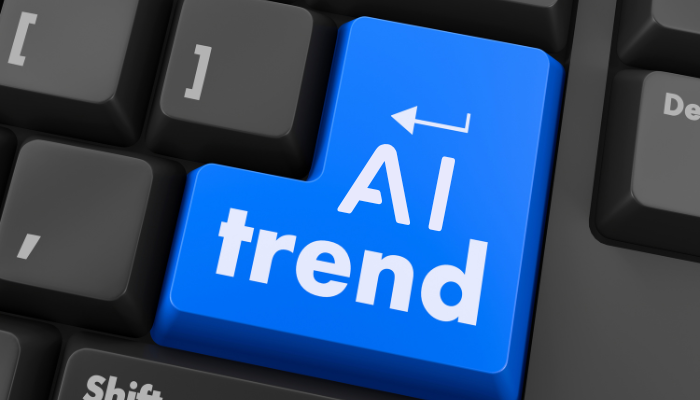Imagine this: A factory line where robots handle everything from assembly to quality control – no breaks, no errors. In fact, they’re even predicting when a machine will need maintenance before it breaks down.
Sounds like something out of a sci-fi movie, right?
But this is happening today, and it’s all thanks to AI-driven automation.
So, have you ever wondered how much time you could save if routine tasks were taken care of automatically? Or how AI could help your team focus on more creative, high-value work instead of repetitive tasks?
It’s time to stop imagining and start exploring how AI is already making a real difference in businesses just like yours.
Understanding Use of AI in Automation
You’ve probably heard a lot about AI and automation, but what does it actually mean?
Simply put, AI in automation is all about using smart technology to do the tasks that we usually need humans for. These AI systems can learn from data, get better over time, and handle jobs that are repetitive or time-consuming, freeing people up to focus on more important work.
Key things to know about use of AI in automation:
- Smart Systems: AI can learn from data and improve over time, making tasks more efficient without human input.
- Routine Task Automation: AI handles repetitive tasks, like answering customer questions or monitoring machines, so humans don’t have to.
- Improved Efficiency: AI can process large amounts of data and perform tasks faster and more accurately than humans.
- Scalable: AI can handle more work without the need for additional human resources, making it scalable for businesses of all sizes.
Now, you might be wondering, “Okay, that all sounds great, but how’s it actually being used?” Let’s take a look at some real-world examples of AI in action.
Real-World Use of AI in Automation:
AI in Customer Service Automation
Customer service teams often deal with high volumes of routine inquiries, leading to delays and frustration for customers. AI is changing this by automating many of the repetitive tasks, ensuring quicker and more accurate responses while allowing human agents to focus on complex issues.
- 24/7 Availability: AI chatbots are always ready to assist, providing immediate answers to common questions, no matter the time of day.
- Quick Resolution: AI handles tasks like processing orders, tracking shipments, and guiding customers through troubleshooting steps without the need for human intervention.
- Seamless Escalation: When the AI encounters a more complex issue, it smoothly transitions the conversation to a human agent, ensuring customers still receive the help they need.
AI in Healthcare Automation
In healthcare, managing patient records, diagnosing conditions, and even scheduling appointments can be time-consuming tasks. AI is making these processes more efficient, freeing up healthcare professionals to focus on patient care.
- Automated Patient Data Processing: AI can process patient information quickly, flagging potential health risks and helping doctors make better-informed decisions.
- Diagnosis Assistance: AI-powered systems analyze medical images, lab results, and patient history to assist doctors in diagnosing conditions more accurately and faster.
- Appointment Scheduling: AI systems can handle scheduling by analyzing doctor availability and patient needs, optimizing time slots, and reducing human error.
AI is helping to improve both administrative and clinical aspects of healthcare, making services more efficient and accessible.
AI in Manufacturing Automation
Manufacturing industries rely heavily on consistent performance and minimizing downtime. AI is transforming production lines by improving quality control, predicting maintenance needs, and automating routine tasks.
- Predictive Maintenance: AI analyzes data from equipment to predict when machines will need maintenance, preventing unexpected breakdowns and reducing downtime.
- Quality Control: AI-powered cameras and sensors monitor production lines for defects, ensuring that products meet the highest quality standards without human inspection.
- Robotic Automation: AI-driven robots handle repetitive tasks such as assembly, packaging, and material handling, speeding up production while maintaining precision.
By automating critical aspects of the manufacturing process, AI helps companies enhance productivity, reduce costs, and minimize errors.
AI in Finance Automation
In the finance industry, speed, accuracy, and risk management are crucial. AI is helping financial institutions improve decision-making, detect fraud, and streamline operations, all while reducing human error.
- Fraud Detection: AI systems can analyze transaction data in real time, flagging suspicious activities and preventing fraudulent transactions before they occur.
- Risk Assessment: AI models analyze historical data to assess risks in investments, helping financial institutions make more informed decisions.
- Automated Trading: AI algorithms can execute trades based on market conditions and trends, optimizing investment strategies and responding to changes much faster than a human could.
With AI, the finance industry is becoming more reliable and smarter, cutting down on mistakes and handling more tasks without needing extra human intervention.
AI in E-Commerce Automation
In e-commerce, staying ahead of customer expectations and managing a vast inventory can be a challenge. AI is helping businesses improve the shopping experience, manage stock more efficiently, and drive sales.
- Personalized Recommendations: AI analyzes customer browsing and purchase history to suggest products they’re likely to be interested in, increasing sales and improving customer satisfaction.
- Inventory Management: AI tracks inventory levels in real-time, predicting when stock will run low and automatically placing orders, so businesses never run out of popular items.
- Customer Support: AI-powered chatbots assist customers with product inquiries, order tracking, and returns, providing immediate help without human intervention.
AI is making e-commerce smarter by automating key processes and creating personalized shopping experiences, helping businesses grow and keeping customers happy.
AI in Supply Chain Management Automation
Managing supply chains involves tracking inventory, predicting demand, and coordinating logistics—tasks that can be time-consuming and prone to human error. AI is transforming this process by providing smarter, more efficient solutions.
- Demand Forecasting: AI analyzes historical sales data, market trends, and external factors to predict demand more accurately, helping businesses plan inventory better.
- Route Optimization: AI tools analyze traffic, weather, and other variables to determine the fastest and most cost-effective delivery routes, saving time and money.
- Automated Warehousing: AI-driven robots and systems manage inventory in warehouses, ensuring products are stored, sorted, and retrieved with precision and speed.
AI is making supply chains more efficient, reducing costs, and helping companies keep products in stock while improving delivery times.
AI in Human Resources Automation
Recruiting, managing, and retaining talent can be a complex and time-consuming task for HR teams. AI is stepping in to help by streamlining processes, improving candidate selection, and even enhancing employee engagement.
- Recruitment Automation: AI scans resumes and applications to identify the best candidates based on specific job criteria, saving HR teams time and effort in the hiring process.
- Employee Engagement: AI-powered tools track employee satisfaction, engagement, and performance, offering insights that help businesses create better workplace experiences.
- Training and Development: AI can recommend personalized training programs for employees based on their performance and career goals, ensuring continuous growth.
AI is helping HR departments work smarter, making hiring and employee management processes more efficient and data-driven.
See how we drive success across industries →
AI in Retail Automation
In retail, keeping customers satisfied and managing inventory efficiently are key to staying competitive. AI is changing how retailers operate, offering new ways to improve both customer experience and back-end processes.
- Personalized Shopping Experience: AI analyzes customer preferences and shopping behavior to create personalized recommendations, boosting sales and enhancing customer loyalty.
- Inventory Optimization: AI systems monitor stock levels in real-time and automatically adjust orders based on demand, helping retailers avoid both overstocking and stockouts.
- Customer Insights: AI analyzes customer interactions and feedback to provide retailers with valuable insights into shopping habits, allowing for better-targeted marketing campaigns.
AI is making retail smarter by automating key processes, improving inventory management, and creating personalized shopping experiences that drive customer satisfaction.
AI in Logistics Automation
Logistics involves managing the flow of goods and services from the point of origin to the final customer. AI is helping businesses optimize routes, predict delivery times, and automate warehouse operations to keep everything running smoothly.
- Route Optimization: AI analyzes traffic patterns, weather, and other real-time data to determine the most efficient delivery routes, reducing travel time and fuel costs.
- Real-Time Tracking: AI-powered systems provide real-time tracking of goods, allowing businesses and customers to monitor deliveries and make adjustments as needed.
- Automated Sorting: AI systems in warehouses sort and route packages with high accuracy, speeding up the process and reducing human error.
AI is transforming logistics by improving efficiency, cutting costs, and enhancing customer satisfaction with faster, more reliable deliveries.
Now that we’ve seen how AI is changing the game across various industries, it’s important to take a step back and think about the challenges and considerations businesses need to keep in mind when adopting AI for automation.
Challenges and Considerations in AI Adoption
AI is full of promise, but it does come with its challenges—costs, data security, and getting your team on board. It might feel like a lot, but with the right approach, these hurdles are totally manageable.
Cost of Implementation
Implementing AI solutions requires both initial and ongoing investments. Here’s a breakdown of key considerations:
- Initial Investment
The upfront cost of purchasing AI software, hardware, and consulting services can be significant. While this is often the largest expense, it’s an investment that pays off by streamlining operations and improving efficiency over time. - Maintenance Costs
Ongoing expenses for system updates, support, and adjustments can add up. Businesses need to budget for these recurring costs to keep their AI systems functioning smoothly and up-to-date. - Training and Development
Employees need training to effectively use AI tools. Investing in their development ensures better adoption and efficiency in using AI for daily tasks, which leads to higher returns in the long run. - Technology Upgrades
AI technologies evolve quickly, so businesses may need to upgrade their systems periodically to keep up with new features and capabilities. This cost tends to be lower than the initial investment but is necessary for staying competitive.
Data Quality and Availability
AI relies on data to function effectively. Without high-quality, clean, and relevant data, AI systems can’t provide accurate results or insights. Here’s what you need to consider:
- Data Collection
Collecting the right data is crucial. Businesses must ensure they’re gathering accurate, consistent, and comprehensive data to feed into AI systems for training and decision-making. - Data Cleansing
Before AI can use data, it needs to be cleaned. This means removing duplicates, correcting errors, and ensuring the data is structured properly. Poor data quality leads to poor AI performance, so investing in data cleaning processes is essential. - Data Integration
Integrating data from multiple sources can be challenging but is necessary for AI systems to make sense of the full picture. Whether it’s from customer databases, social media, or sales reports, ensuring all data flows into one cohesive system will improve AI accuracy and effectiveness. - Data Security
As businesses collect more data, protecting it becomes increasingly important. AI systems must comply with privacy regulations like GDPR, and companies need to implement strong security measures to protect sensitive information.
Change Management
Introducing AI into your business processes means significant changes to how things are done. It’s essential to manage these transitions carefully to ensure smooth adoption and long-term success.
- Employee Buy-in
One of the biggest challenges is getting employees to embrace AI. It’s important to involve your team early, explaining how AI will enhance their roles rather than replace them. Clear communication is key to reducing resistance and ensuring they feel confident using the new technology. - Training and Support
Providing ongoing training is crucial to ensure employees can use AI effectively. Along with formal training, having a support system in place helps employees navigate any difficulties they encounter as they adjust to new tools and processes. - Cultural Shift
Implementing AI can create a shift in workplace culture. Businesses need to foster an environment where employees are encouraged to embrace new technologies, collaborate with AI, and continuously innovate to stay ahead. - Managing Expectations
It’s important to manage expectations about what AI can and can’t do. AI is a powerful tool, but it’s not a magical fix for every problem. Businesses should focus on realistic goals and timelines for implementing AI solutions to ensure smooth integration.
Privacy and Security Concerns
As AI systems handle increasing amounts of sensitive data, privacy and security become critical considerations. Ensuring that these systems are secure is essential to maintaining customer trust and meeting regulatory requirements.
- Data Protection
AI systems must be designed to protect sensitive information. This includes using encryption, secure storage methods, and access controls to ensure data is only accessible by authorized personnel. Protecting customer data is vital to avoiding security breaches and compliance issues. - Regulatory Compliance
Businesses need to ensure their AI systems comply with privacy regulations like GDPR, CCPA, and other data protection laws. Failing to comply with these regulations can lead to costly fines and damage to a company’s reputation. - Bias and Fairness
AI systems are only as good as the data they’re trained on. If the data is biased, AI models can produce unfair or discriminatory outcomes. Ensuring your AI systems are built with fairness in mind is crucial for ethical and legal reasons.
Use of AI in Automation: Finding the Right Partner
Imagine this: Your business is growing, and with that growth comes a higher demand for efficiency. You want to streamline your operations, automate repetitive tasks, and make smarter, data-driven decisions. But as you start exploring AI solutions, you quickly realize that implementing AI is not as simple as just installing a new tool.
You’re faced with questions like:
- How do you choose the right AI technology for your specific needs?
- How do you integrate AI seamlessly into your existing systems without causing disruptions?
- How do you ensure that the solution scales with your growing business?
At this point, you need more than just a tool. You need a partner who understands the complexities of AI in automation and can guide you through every step of the process.
This is where Codewave comes in. With years of expertise in AI and automation, we provide tailored solutions that fit your unique business challenges.
We don’t just offer a one-size-fits-all product; we take the time to understand your specific needs and deliver an AI-driven automation strategy designed for maximum impact.
Up Next: Want to automate your testing? See why AI is the best solution for 2024 and beyond!
Codewave is a UX first design thinking & digital transformation services company, designing & engineering innovative mobile apps, cloud, & edge solutions.







